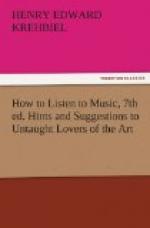[Sidenote: What may be heard from a band.]
The most eloquent, potent, and capable instrument of music in the world is the modern orchestra. It is the instrument whose employment by the classical composers and the geniuses of the Romantic School in the middle of our century marks the high tide of the musical art. It is an instrument, moreover, which is never played upon without giving a great object-lesson in musical analysis, without inviting the eye to help the ear to discern the cause of the sounds which ravish our senses and stir up pleasurable emotions. Yet the popular knowledge of its constituent parts, of the individual value and mission of the factors which go to make up its sum, is scarcely greater than the popular knowledge of the structure of a symphony or sonata. All this is the more deplorable since at least a rudimentary knowledge of these things might easily be gained, and in gaining it the student would find a unique intellectual enjoyment, and have his ears unconsciously opened to a thousand beauties in the music never perceived before. He would learn, for instance, to distinguish the characteristic timbre of each of the instruments in the band; and after that to the delight found in what may be called the primary colors he would add that which comes from analyzing the vast number of tints which are the products of combination. Noting the capacity of the various instruments and the manner in which they are employed, he would get glimpses into the mental workshop of the composer. He would discover that there are conventional means of expression in his art analogous to those in the other arts; and collating his methods with the effects produced, he would learn something of the creative artist’s purposes. He would find that while his merely sensuous enjoyment would be left unimpaired, and the emotional excitement which is a legitimate fruit of musical performance unchecked, these pleasures would have others consorted with them. His intellectual faculties would be agreeably excited, and he would enjoy the pleasures of memory, which are exemplified in music more delightfully and more frequently than in any other art, because of the role which repetition of parts plays in musical composition.
[Sidenote: Familiar instruments.]
[Sidenote: The instrumental choirs.]
The argument is as valid in the study of musical forms as in the study of the orchestra, but it is the latter that is our particular business in this chapter. Everybody listening to an orchestral concert recognizes the physical forms of the violins, flutes, cornets, and big drum; but even of these familiar instruments the voices are not always recognized. As for the rest of the harmonious fraternity, few give heed to them, even while enjoying the music which they produce; yet with a few words of direction anybody can study the instruments of the band at an orchestral concert. Let him first recognize the fact that to the mind




